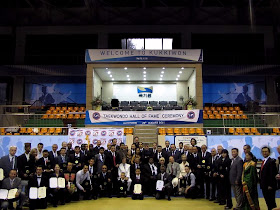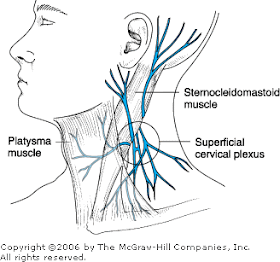To my surprise a recent post in which I argue that
Taekwon-Do is not a good system for civilian defence opened up a can of worms on a martial art forum. Actually it is not really surprising as the post was intended to be somewhat controversial. I am after all saying that the “Korean Art of Self-Defence” is not good for self-defence. What was surprising is not that people are talking about it, but rather who is talking about it. I would have thought that primarily Taekwon-Do people would take offence, but it seems like it is some people in the traditional martial art community in general, rather than the Taekwon-Do community in particular, who is taking offence. And coming to my defence are Taekwon-Do practitioners, but also practitioners of other traditional martial arts; including in part Dan Djurdjevic, a fellow
blogger and martial artist to whom I have referred to on a number of occasions here on the
Soo Shim Kwan blog.
You can see the thread where the discussion is happening
here.
I decided that I'm not going to engage in the conversation on the thread. Not because I don't like such discussions, but rather because of the lack of time at present to devote to it on a forum. (Forum discussion usually span days and I'm in the middle of Midterm exams requiring me to grade a multitude of papers for at least two weeks.) Also, the post I wrote is part of a larger series of posts (at least in my mind) that started with “
What's the Difference Between Taekwon-Do and Hapkido?” and continued with “
Techniques: when serious harm is not intended”. Since I'm still in the process of building my argument through these posts I don't want to argue my case just yet as I'm still exploring it for myself.
Back to the
thread I mentioned: What I have garnered from the discussion there is that I might be misunderstood to say that Taekwon-Do (and by implication all traditional martial arts) are too dangerous for self-defence because every traditional technique is so potentially lethal. To this I have to reply both yes and no. I will not speak for other traditional arts like for instance Karate, because I'm not a Karateka. I'm speaking solely now for (ITF) Taekwon-Do. Yes, I think that original Taekwon-Do, which I called “authentic”[1] Taekwon-Do in the mentioned post, is not appropriate for civilian defence, because, yes, it is/was too lethal.
 |
The Taekwon-Do pagoda (monument) at
the military base on Jeju Island where
"original" Taekwon-Do was developed as
part of the 29th Infantry Division in the 1950s. |
Taekwon-Do—contrary to what the South Korean marketers would have you believe—is not 2000 years old. It did not start as a traditional martial art. While original Taekwon-Do does have roots in primarily Shotokan Karate and some Taekkyeon, as well as some other styles, it's primary development occurred in the 29th Infantry Division of the South Korean Army. At that time it's purpose was as a military combat system. The immediate context was World War II and the Korean War—this is what it was developed for: as a system of hand-to-hand combat to be used in the types of wars of the time. Those involved in developing it were war veterans and some of them, for example Major Nam Tae-Hi, had actual hand-to-hand combat experience on the battlefield. It was later applied and battle tested during the Vietnam War. This is the context of Taekwon-Do's development—actual real war. There are different sources you can read up on this. The one I like the most is
A Killing Art: The Untold History of Tae Kwon Do
. (I'm looking forward to read Master George Vitale's recent doctoral thesis on the history of Taekwon-Do.)
 |
Centre: Major Nam Tae Hi, teaching Taekwon-Do
to the Vietnamese Military in the 1960s.
Image Source |
In its original form, Taekwon-Do was excessively hard and not appropriate for civilian defence. The type of training involved is also not something that most normal civilians would wish to endure. Practically all of those original masters are suffering from serious arthritis, terrible knee and / or hip joint problems and other ailments that can be directly linked to the harsh type of training they partook in. Original Taekwon-Do, as practised in the early South Korean military, was not meant for civilian use. Taekwon-Do only later became a traditional martial art taught to civilians; the moment it started being taught to civilians it started to change.
The other point I made in my post was that Taekwon-Do as it is mostly taught today is nothing like original Taekwon-Do. It is something that is terribly watered down and it too is not appropriate for civilian self-defence, not because it is necessarily too dangerous; rather the opposite. In this watered down state, what is taught as “self-defence” is usually unrealistic. (See: “
Why I Don't Like Your Self-Defence”.) It is furthermore not good as a civilian defence system because unlike many other traditional martial arts it does not have a fully developed arsenal of “control” techniques. While control techniques are not the only valuable techniques for civilian defence, they definitely are one important set of techniques for civilian defence.
The reason Taekwon-Do does not have a proper arsenal of control techniques is because it was not originally meant as a civilian defence system—it was meant as a military combat system. The original control techniques that Taekwon-Do could have inherited from the styles (e.g. Karate and Taekkyeon) it developed out of were mostly dropped because such techniques were not considered effective for military combat. Remember that a military combat system is an infantryman's last resort. It is used when your artillery failed. You don't use it to control the enemy, like a policeman might do with a petty-criminal, you use it in a desperate act of defence in which it is quite likely that you will die, lest you eliminate the enemy soldier directly in front of you as swiftly as possible.
 |
A photo of Hapkido "founder" Choi Yong Sul with
students in 1951. While Taekwon-Do was developing
in the military, Hapkido was being established outside
the military; i.e. as a civilian martial art.
Image Source |
The other thing that prevented Taekwon-Do from building up an arsenal of control techniques is that another martial art entered the civilian scene while Taekwon-Do was still focussing on the military scene—Hapkido; and unlike Taekwon-Do, Hapkido was at the time almost exclusively preoccupied with control techniques. Early Hapkido (known as Hapki-Yoosool) was for all intends and purposes basically Japanese jujitsu—more specifically, Daito Ryu Aiki-Jujutsu. This earliest form of Hapkido had practically no strikes or kicks. These only came later. I'm hypothesizing that while Taekwon-Do filled the military combat niche back then, Hapkido filled the civilian defence niche. No wonder that when Taekwon-Do did become a system taught to civilians in Korea it evolved into something wholly different—a sport, in the form of WTF taekwondo [2]—for that was the obvious remaining niche [3]. Hapkido techniques were assimilated into Taekwon-Do, but this obviously occurred later.
For Taekwon-Do to function as a proper civilian defence system requires a number of things. I mentioned some of those things in the
previous post. For one, it must take account of what is currently taught as self-defence and admit that it is not very reflective of reality. Also, it needs more “soft” style techniques. This is what I'm currently researching—the soft techniques in Taekwon-Do and how they can be used for civilian defensive purposes. The specific type of techniques I'm currently preoccupied with is pushing techniques.
I'm not saying that Taekwon-Do cannot be used for (civilian) self-defence. It can. However,
the current thing that is most commonly taught as “self-defence” in many Taekwon-dojang is not appropriate for actual real life self-defence. Neither is a complete return to Taekwon-Do's military combat roots. The solution is to be found some place else and will also require the adoption of “foreign” techniques. Many instructors have already done so (as have I), so some people reading this post may actually have no idea what the whole fuss is about.
Finally, I'm speaking of “
civilian self-defence” contextualised within a relatively “civil society.”
Footnote 1: I used the term “authentic” Taekwon-Do in the previous post, rather than “original” Taekwon-Do. The reason is because of the many splits in Taekwon-Do many people are claiming to teach “original” Taekwon-Do. What I am actually trying to say when I use “authentic” or “original” Taekwon-Do with in the context of these post is that early form of Taekwon-Do that developed within the 29th Infantry Division of the South Korean Army in the 1950s.
Footnote 2: The taekwondo currently taught to soldiers in general in the South Korean military is not the original actual combat focussed version that it once was. Now it is a version of Kukki/WTF taekwondo and soldiers are actually awarded Kukki/WTF black belts during their military service. Soldiers in special force units, for instance the South Korean navy seals learn a different and much more effective hand-to-hand combat system.
Footnote 3: There is actually another remaining niche, an ascetic one. In Korea the most iconic martial art focussing on asceticism is probably Seon Moo Do (Zen Martial Way), practised at two or three Buddhist monasteries in South Korea. There is, however, no mainstream martial art with a clear ascetic focus in Korea, in the same way as Aikido in Japan. Most all Korean martial arts have some ascetic components, ITF Taekwon-Do slightly more so than most, but it is not so heavily focussed that one could call them true ascetic martial arts, and none really fill the ascetic niche. Unlike Japan that is a mostly secular society and an ascetic martial art like Aikido may actually fill some “spiritual” need, Korea is not as secular. Both Christianity and Buddhism are very active in South Korea, so that an ascetic search is more likely to be catered for by religion than martial arts.






















